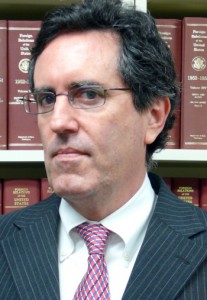
A SPOTLIGHT ON “TOP SECRET AMERICA”
Most people can vaguely recall that there was once no U.S. Department of Homeland Security and that there was a time when you didn't have to take your shoes off before boarding an airplane or submit to other dubious security practices.
But hardly anyone truly comprehends the enormous expansion of the military, intelligence and homeland security bureaucracy that has occurred over the past decade, and the often irrational transformation of American life that has accompanied it.
The great virtue of the new book Top Secret America by Dana Priest and William M. Arkin (Little Brown, September 2011) is that it illuminates various facets of our secret government, lifting them from the periphery of awareness to full, sustained attention.
Top Secret America, which builds on the series of stories the authors produced for the Washington Post in July 2010, delineates the contours of “the new American security state.” Since 9/11, for example, some 33 large office complexes for top secret intelligence work have been completed in the Washington DC area, the equivalent in size of nearly three Pentagons. More than 250,000 contractors are working on top secret programs. A bewildering number of agencies – more than a thousand — have been created to execute security policy, including at least 24 new organizations last year alone. And so on.
But the vast scale of this activity says nothing about its quality or utility. The authors, who are scrupulous in their presentation of the facts, are critical in their evaluation:
“One of the greatest secrets of Top Secret America is its disturbing dysfunction.”
“Ten years after the attacks of 9/11, more secret projects, more secret organizations, more secret authorities, more secret decision making, more watchlists, and more databases are not the answer to every problem. In fact, more has become too much.”
“It is time to close the decade-long chapter of fear, to confront the colossal sum of money that could have been saved or better spent, to remember what we are truly defending, and in doing so, to begin a new era of openness and better security against our enemies.”
(From this point of view, it was disappointing to hear the former chair of the 9/11 Commission, Gov. Tom Kean, declare yesterday that “we are not as secure as we could or should be.” We need to accelerate along the path we have been following, Gov. Kean seemed to say, not to fundamentally change course.)
According to Priest and Arkin, “The government has still not engaged the American people in an honest conversation about terrorism and the appropriate U.S. response to it. We hope our book will promote one.”
Despite the sobering subject matter, Top Secret America actually makes for lively reading. It is full of the authors' remarkable insights, anecdotes and encounters. Dana Priest explored some of the physical geography of the classified world, taking elevators to unmarked floors in suburban office buildings and driving up to guard booths at secret facilities to innocently ask for information. She accompanied police in Memphis while they conducted neighborhood surveillance with newfangled automatic license plate readers. She was polygraphed at her request — and found to be a poor liar. Bill Arkin, whose painstaking research informed the entire work (which is narrated by Priest), spent ten days in Qatar at the U.S. military facility that controls air operations in Iraq, Afghanistan and Pakistan, and somehow got himself invited to classified briefings.
One question that lurks throughout the book is whether the excesses and misjudgments that constitute so much of Top Secret America can be corrected or reversed. The authors are not very optimistic, particularly since there are so many people who benefit from current arrangements, however wasteful, useless or pointless they might be.
By way of illustration they cite U.S. Northern Command, the newest military command that is nominally responsible for defense of North America but in practice is largely subordinate to other agencies and organizations. “The fact that Northern Command would even continue to exist as a major, four-star-led, geographic military command, with virtually no responsibilities, no competencies, and no unique role to fill, demonstrated the resiliency of institutions created in the wake of 9/11 and just how difficult it would be to ever actually shrink Top Secret America,” they wrote.
Secrecy is naturally a persistent theme throughout the book. As is often the case in national security reporting, the authors relied on unauthorized disclosures to complement their own research and reporting. And in this case, such disclosures served as a particularly effective antidote to overclassification.
“Most of those who helped us did so with the knowledge that they were breaking some internal agency rule in doing so; they proceeded anyway because they wanted us to have a more complete picture of the inner workings of the post-9/11 world we sought to describe and because they, too, believe too much information is classified for no good reason,” they wrote.
At the same time, the authors noted that they “have left out some information” based on national security considerations.
Top Secret America will be featured on PBS Frontline on September 6, the book's official release date.



